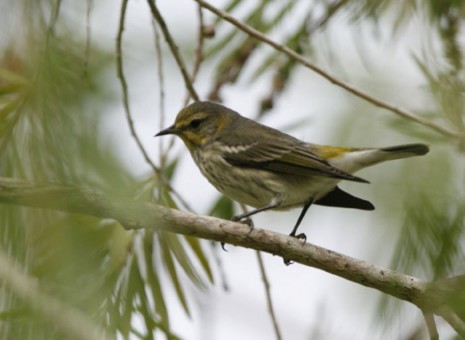Wayne R. Petersen

Wayne Petersen
The thin, sharply pointed and slightly downcurved bill, combined with the slender legs and overall slim shape of this month’s puzzler all point to a warbler. The single obvious wing bar and heavily streaked underparts offer useful information about its specific identity. For many warblers, the presence or absence of wing bars, along with the presence or absence of streaks on the underparts, can place an unfamiliar warbler into one or another smaller group. Once this easy first cut is made, additional subtle features can eventually lead to identification of the species.
Careful scrutiny of the picture fails to reveal any noticeable streaks on the back, but there are blurry, i.e., not crisp and sharp, streaks on the underparts. The bird also has a strong pale wing bar on the median coverts, a bare trace of a wing bar on the greater secondary coverts, a modestly defined stripe over the eye, and a relatively short tail showing at least one white underside spot. A peek at the color version online reveals a diffuse, light-colored patch on the side of the neck below an otherwise dusky- olive cheek, a dull yellow rump, and whitish undertail coverts. This combination of features makes it is easy to eliminate a number of possibilities.
Having prominent and extensive ventral streaks is a feature shared by the Ovenbird, the waterthrushes, and the Black-and-white, Cape May, Cerulean, Magnolia, Blackburnian, Blackpoll, Palm, Yellow-rumped, and Black-throated Green warblers. We can, however, eliminate as candidates the Ovenbird, the waterthrushes, and the Black-and-white, Cerulean, Blackburnian, and Black-throated Green warblers because all of these birds have either conspicuous and prominent eye stripes, two obvious wing bars, or some clearly distinctive facial marking. The most realistic possibilities thus become Cape May, Magnolia, Blackpoll, or Yellow-rumped warbler. The Blackpoll and Yellow-rumped warblers can be eliminated because among other features they have conspicuous streaks on their backs, and the Palm Warbler would never show the distinctive single wing bar of the mystery warbler. The ventral streaking on a Magnolia Warbler would be darker and more obvious and the white tail spots would produce a cross-banded effect not exhibited by the mystery bird. An immature Magnolia Warbler would show fewer and less prominent ventral streaks in addition to being bright yellow when viewed in the color photograph. This leaves only the Cape May Warbler (Setophaga tigrina) as a possibility, which indeed is what the mystery species is—an adult female Cape May Warbler in nonbreeding plumage.
Cape May Warblers are generally uncommon to very uncommon spring and fall migrants throughout Massachusetts. In some autumns, however, they can be quite numerous at outer coastal migrant traps or on offshore islands, particularly following outbreaks of spruce budworms in the boreal forests of eastern and central Canada where most of the population breeds. The author photographed this Cape May Warbler in Cuba on November 10, 2008.